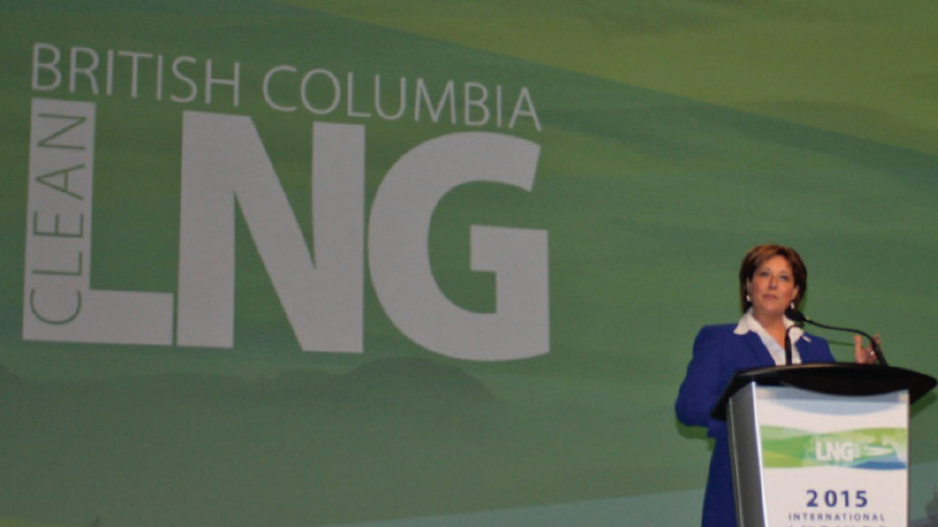One year ago, the last time global oil and gas companies converged in Vancouver for an annual conference on B.C.’s nascent liquefied natural gas (LNG) industry, it was a different world.
Oil prices were double what they are now, and the economic powerhouse that is China was still humming.
Since then, oil and gas prices have plunged many energy companies into survival mode, China’s economic growth is confirmed to be cooling, and there’s a glut of LNG on the global market, thanks to new production, mostly from Australia.
“It’s definitely a more difficult environment to sanction the projects than it was last year when prices were higher, affordability was better and demand was stronger,” said Mary Hemmingsen, KPMG Canada’s LNG, power and utilities leader, who recently published an analysis of Canada’s potential for developing an LNG industry.
When energy companies began investing in B.C., they were in a race with Australia and other LNG-producing nations to lock up 20-year contracts with Asian buyers – contracts that were coming up for renewal.
That window has now closed, Hemmingsen said, so projects being developed in B.C. will be focused on longer-term demand.
She estimated that the annual global LNG demand is about 300 million tonnes, and Australia is expected to add 75 million tonnes per annum between now and 2018.
Australian LNG projects were beset by huge cost overruns, and Asian partners are now struggling to absorb their commitments, said Eiji Yanagawa, Mitsui & Co.’s (Nasdaq:MITSY) general manager of global natural gas development.
Yanagawa said there will be no need for any new LNG supplies over the next two or three years.
Large LNG projects like the ones proposed for B.C. require capital investments in the $40 billion to $50 billion range. Faced with weak oil prices and shrinking revenue, there are fears that companies like Petronas and Shell (NYSE:RDB.B) will postpone their investments in B.C. and wait for a recovery in oil prices.
“The big challenge is the capital rationing that is going on in the industry because the broader oil and gas industry is in distress,” Hemmingsen said.
But the CEOs for both Pacific NorthWest LNG (Petronas) and LNG Canada (Shell) told last week’s LNG in BC conference that their companies are still on track with their respective final investment decisions.
Hemmingsen said the key for any LNG project in B.C. will be reducing costs through better workforce management and applying a modular approach to building LNG plants.
One advantage B.C. now has in developing longer-term markets is the federal government’s decision earlier this year to extend LNG export licences to 40 years from 25.
“That’s a great advantage that we have,” said Andy Calitz, CEO for Shell’s LNG Canada.
So what is the long-term demand for LNG four decades out?
Despite an expected short-term oversupply, the longer-term demand in Asia is expected to grow along with its economies and population.
Asia accounts for more than 70% of the world’s LNG demand, Hemmingsen said, with Japan taking 50% and South Korea 20%.
Japan was expected to require significantly more LNG following the Fukushima nuclear disaster, because it was expected to phase out nuclear power. But there is some doubt now over whether that will happen.
China and India are considered the two biggest potential new markets for B.C. gas. Both have serious air pollution problems that can be addressed only by replacing coal with cleaner energy sources.
China gets about half of its natural gas from pipelines. Russia is expected to become a major supplier of pipeline gas, and China has large deposits of shale gas.
But Liu Deshun, director general for China’s department of oil and gas, said the country’s natural gas consumption is expected to double between now and 2020. He said China’s shale gas industry is still in its infancy and pipeline gas is more than 5,000 kilometres from Eastern China, so neither domestic production nor pipeline gas will be adequate to meet China’s future demand.
The challenge for any producer, he said, will be pricing. In other words, low-cost producers will have the edge in China.
As for India, its population is expected to exceed China’s by 2029, its economy is expected to match Japan’s by 2035 and it has little domestic oil and gas. It will therefore need more of both, said Santosh Srivastava, executive vice-president of IndOil Montney Ltd.
India is already the world’s fourth-largest energy consumer.
B.C. is competing with other LNG-producing nations for market share. Taking lessons from Australia, where LNG project budgets ballooned, due largely to labour costs, B.C. has done a good job of ensuring a taxation and regulatory environment that will make B.C. competitive, industry leaders say.
It has also done a good job of anticipating LNG’s large workforce needs. The government has worked with industry, post-secondary institutes and labour organizations to provide skills training, particularly among First Nations, which are becoming key partners in the LNG sector.
“We’ve already invested $3 billion for the Skills for Jobs Blueprint over the next 10 years,” Premier Christy Clark said at last week’s conference.
Despite First Nations’ legal challenges to Pacific NorthWest LNG in Prince Rupert, there has generally been support for LNG projects among B.C. First Nations.
The Haisla and Nisga’a First Nations, for example, have become partners in a variety of LNG projects, and last week the Squamish Nation gave a tentative green light to the Woodfibre LNG project.
To date, Clark said 61 agreements with 28 First Nations along pipeline routes for LNG projects have been signed.
Clark said 30 companies have thus far invested $12.5 billion in B.C. to develop an LNG industry. Last year, there were 13 LNG projects proposed for the province. Today there are 20. •




